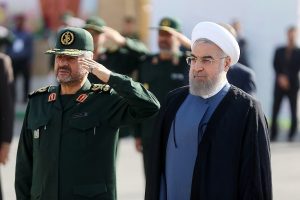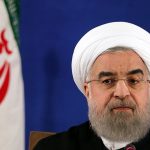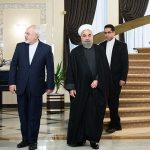by Siamak Tundra Naficy
The Trump administration has again generated confusion about its foreign policy, this time regarding the motivations of an American president who would order a limited strike on Iran only to then purportedly change his mind 600 seconds before the attack. Trump apparently also notified the Iranians prior to the aborted attack, issuing an ultimatum to speak with Supreme Leader Ali Khamenei, which Iran rejected.
A limited strike on Iran would have demonstrated U.S. reluctance, rather than a strong-headed willingness, to intervene. Moreover, any such kinetic action would also be an admission that the maximum pressure campaign on Iran has failed. This is something that Trump is loath to concede. As such, he is forced to imagine or pretend, that the shooting down of the American drone was a “big mistake,” for otherwise, his administration’s efforts have not brought the Iranians to heel but instead closer to war.
Many Iran hawks have been critical of Trump’s unfulfilled strikes, warning that “weakness is provocative” or claiming that this tough talk combined with a reluctance to follow through hurts U.S. “credibility.” But recent history suggests that a limited tit-for-tat cycle of conflict against Iran would not restore deterrence credibility for the United States. The overthrow and killing of Libyan leader Muammar Qaddafi didn’t stop Syria’s Bashar al-Assad from dropping barrel bombs and committing other atrocities in Syria. In fact, the United States, twice under Donald Trump, has lobbed cruise missiles at Syria for its alleged use of chemical weapons. These strikes have not deterred the Iranians from standing up to the United States today.
A riskier and more unrestrained bombing campaign might awe both domestic audiences and audiences abroad. But Washington again would then risk exchanging one humiliation (ultimatums) for another (resistance).
Strength, Independence, and Local Politics
Other leaders also worry about looking tough and hold core interests that they are willing to defend with force. In every geopolitical competition in history—and the U.S.-Iran conflict is certainly one—rivals have found ways to disregard rules, twist their own principles, and sacrifice loyal populations—but they have also made bargains and compromised when it suited them. Repeating ahistorical hymns of us (good) vs. them (bad) won’t make these facts go away.
Khamenei has expressed his philosophy that the “only way to confront the brazen enemy is by firm determination, not passiveness.” He has also noted that “our enemies still do not know Iranian people, Iranian officials. This is why they are bullying us. The nation and the government that emerged from it will not yield to bullying demands.” If anything, the U.S. withdrawal from the Joint Comprehensive Plan of Action (JCPOA) and violations of the agreement—while insisting that Iran stick to the same—have helped to underscore Khamenei’s rhetoric. It’s an old rule of deterrence: don’t give in to bullies. Compromises and concessions made under duress and coercion will simply encourage more demands by both the aggressor as well as any third-parties.
In other words, even if Iran is open to pursuing broad-based negotiations with the United States, Iranians must be seen as actors helping to drive the process, rather than being subject to the demands (and whims) of the American president. In this way, the recent escalation in fact opens the door for communication, provided the United States can play its part. .
The Potentials of Maximal Diplomacy
Various issues critical to U.S. national security interests—Iraq, Syria, Israel, Palestine, Afghanistan, energy, security, non-proliferation cannot be solved without Iranian participation. The United States has tried to solve these over the past 10 to 15 years without the Iranians, but with limited success. The only thing Washington has not tried is sustained talks with, and not at, Iranians. With the signing of the JCPOA, the Iranians arguably demonstrated that they were willing to give up something significant up front to get what they really wanted, which is to talk about all of the other issues beyond Iran’s nuclear energy program.
Unfortunately, since 1979, missed opportunities and reciprocal belligerence seem to be the persistent conditions in Iran-U.S. relations. When one side has been willing to pursue dialogue, the other has proved evasive, while both have shown an appetite for escalation. As early as 1986, Iranians looked for possibilities of a reconciliation with the United States, exploring covert channels arranged and facilitated by Israel. They hoped to be able to exchange badly needed arms in the war started by Iraq, and were willing to fund U.S.-backed Contras who were not getting the congressional support that Reagan wanted. This is why National Security Advisor Robert MacFarland made the trip to Tehran. But, of course, details of the “Iran-Contra affair” were in time leaked to the public, temporarily embarrassing those involved.
Because of the Iran-Contra affair, both sides shied away from further attempts at dialogue and rapprochement for many years—especially Republicans in the U.S. and conservatives in Iran. Things didn’t start to fall into place again until 2015, when the two sides succeeded in a binding deal that was to be a first step towards real possible rapprochement—one that was quickly abandoned by the Trump administration. So, once again, by misunderstanding the nature and roots of the conflict, the two countries are on the verge of a military conflict that saner people on both sides would independently seek to avoid.
The U.S.-Iran conflict is not so much a “clash of civilizations” or competing ideologies as much as a crash of core national interests. It involves Iran, a regional power, attempting to remove itself from a patron-client relationship with the United States, a superpower. Iran’s foreign polices might at times be provocative, but the country’s leaders are not irrational. More to the point, they are predictable from the standpoint of the overlap between foreign policy and domestic politics. In this way, even a secular, democratic Iran would have areas of mutual interest (a stable Iraq or Afghanistan, for instance) and disagreements (Iran’s role in the global energy market) with the United States. Unless the United States is truly interested in no longer being the global anchor for regional stability and instead favors more regional anchors stabilizing their own regions, these factors will not change.
A Way Forward
Large-scale intractable conflicts are complex, not complicated problems, meaning that they are more difficult to understand, predict, or influence. Many traditional and conventional conflict-resolution strategies are predicated on the idea of complicated systems where actors behave in predictable, interest-based ways with the expectation that a win-win resolution is possible. Proxies and client-states behave as puppets, never seeking a goal that is at odds with their patron’s. So, if the process doesn’t work, it’s wrongly understood that one or more actors were not acting rationally. In this way, negotiators encourage (or force) actors to put aside emotions and focus on the utilitarian value of the offers (as determined by negotiators).
But understanding the relationship between the diplomatic process and the emotions people can’t leave at home (because of history) or won’t leave at home (because of the constraints of domestic politics) is crucial to any potential success. Foreign policy only comes out of the available positions, personalities, and circumstances of a nation’s domestic politics. Despite what realists might say regarding security dilemmas and balance-of-power posturing, recall what the late former Speaker of the House, Tip O’Neal said, “All politics are local.”
The domestic politics of Iran prove crucial to understanding its foreign policy in the same way as the local politics of the United States affect and overlap with its foreign policy. In this way, Iran may have far less wiggle room than most assume when it comes to the United States (especially compared to, say, the Kim Jong Un regime). Likewise, the United States may also have less wiggle room than many might imagine, given the lack of both congressional and popular appetite for war.
As such, any talks must recognize, first, the length of time required to build trust, which is necessary to get beyond past sermonizing, grandstanding, and demands. Forty years of enmity and narrative-making cannot be undone over the course of a single meeting. Both sides will need to seek a kind of compromise that leaves everyone with something—but no one with everything.
Second, participants should go after obvious areas of common agreement, such as an end to the humanitarian crisis in Yemen, continued vigilance against the Islamic State and al-Qaeda, countering narcotics from Afghanistan, and a stable government in Iraq. Because diplomacy rarely yields any immediate or lasting results, both sides must return home with some small, but tangible deliverables to counteract the many spoilers who will be lying in wait both at home and abroad. Only by building such impetus can the negotiators aspire to tackle the truly complex problems, such as oil sanctions or the possible military potential of Iran’s nuclear program.
It’s a difficult process and it’s only fair to be skeptical, but it would be unfair to say it cannot be done. Intractable conflicts tend be imagined as intractable until they’re not. As such, diplomats need realistic goals. Immediate and complete resolution is unfortunately often not realistic. Instead, realistic, modest objectives that help facilitate more constructive interactions can be enormously positive.
Very tough challenges lie ahead, but this process could succeed (not that it will succeed). Otherwise, what’s the point of diplomacy? As Moshe Dayan, a former Israeli defense minister once quipped, “If you want to make peace, you don’t talk to your friends. You talk to your enemies.” Similarly, no one ever says that “we should give war one day and if that doesn’t work, wage full-scale diplomacy no matter how long it takes.” But maybe it is time to try.






Non-violent resistance is the only way to overcome the enemy. It is written in the Zend-Avesta.
MR. Siamak Tundra Naficy
Where is your proof that Syria dropped barrels bomb on civilians. Hope your sources are not same anon sources used by NYT, BBC and CNN.
We know western media lied about the alleged chemical attacks. To be credible you should stop using rhetoric as analysis. Well that is unless you
rather be paid as a propagandist of a western tank for not thinking. Shame on you
Kooshy
Barrel Bombs are just another way of killing people from the air.
References to it was always a point of propaganda by enemies of the Syrian Arab Republic to persuade the middle class & the feeble minded to join or to otherwise support the destruction of SAR.
I suppose Al Assad ought to have used a more humane method of killing his enemies, the assorted rebels and jihadists – say Lethal Injection, anyone?
Kooshy,
The author’s source could be the terrorist group with the white helmets! They’re the one who claimed first that the Syriain government was dropping barrels or cluster bombs from the air! Which it was proven to be a lie later and apparently they were using this lie as a pretext for their masters in order to escalate the war. Of course later on, some evidences surfaced that the terrorists with White Helmets were using Chlorine gas on civilians!
a lot of nonsensical vacuous statements despite good intentions barely worth the read! Author maybe a good anthropologist but makes a poor political analyst